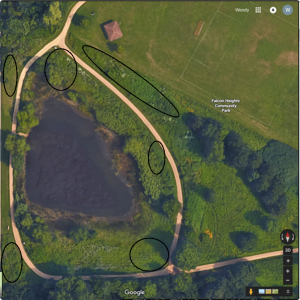Finding a site with milkweed is the first step in participating in the MLMP and often the trickiest for many volunteers. Most species of milkweed grow extremely well in disturbed areas, so logical places to look include pastures, roadsides, bike paths, agricultural fields, vacant land, or cultivated gardens. Natural and restored prairies, CRP land, nature centers, and park preserves frequently have patches of milkweed that have already been identified or can be readily located. If you are using land that is owned by someone else (either privately or publicly), let the owner know about the project and obtain their permission to monitor the land. Wonderful partnerships have been formed and community interest sparked when monitoring a site outside of your own backyard. More information about finding a site can be found on our “Get Started” page.
Defining your Site

The number of milkweed plants at monitoring sites varies from just a few in a small garden to several hundred in a large field. When you define your site, think about the large contiguous area in which the milkweed is growing, not the seemingly separate patches of milkweed that appear throughout the site. For example, if you are monitoring milkweed in your garden, the milkweed may be concentrated in a small area, but the entire garden is actually your measured site. If you are monitoring a meadow that has milkweed by the pond, another patch by the road, and a third patch on the hillside, do not treat these as three separate sites but rather part of a large site that is biologically similar and measure it accordingly.
For example, this park is near MLMP headquarters in Minnesota. The area of the site is approximately one acre. The black outlines represent areas where milkweed is growing in dense patches and there are a few scattered milkweeds throughout the rest of the site. This entire area is considered one site, not six individual sites because milkweed is scattered throughout this biologically similar area.
There are exceptions to these general rules. If, for example, you are monitoring a large field in which there is only one dense patch of milkweed and there are no other milkweed plants throughout the site, you might decide that this patch alone is your site. Likewise, if the meadow described above has a patch of swamp milkweed near a pond and common milkweed scattered throughout the rest of the site, you may decide to consider the pond milkweed as part of a separate site. A good general rule is: if you have a biological reason for calling two milkweed patches two separate sites, you should do so. Otherwise, don’t.
Generally, we require a site to have at least 10 milkweed plants, however this is not a hard and fast rule.

